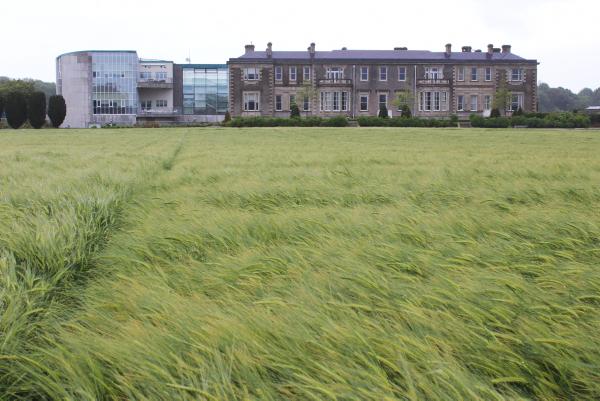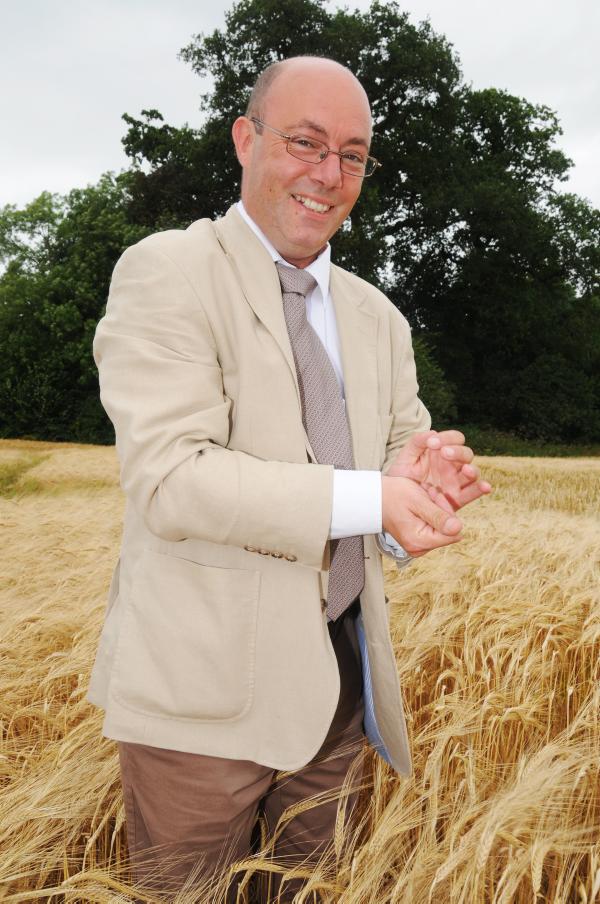Teagasc Oak Park Crop Research station, the home of the national centre for arable crops research, is based in Carlow town on 322ha. Along with the vast area of land for trial cropping, the centre also has 43ha of old estate forestry. Almost 200ha are used for arable cropping, with 60ha used for forage. The Oak Park forest walks provide a recreational area for locals. This is owned by Teagasc but is leased to the county council.
The estate was originally owned by Bruens, who had around 25,000 acres in Carlow and surrounding areas. The last Bruen family on the estate had a daughter, but the estate was left to a nephew, who sold it to an English farming company. The estate was then bought by the Land Commission and the land was divided up, with some set aside for agricultural research, some for the rugby club and golf club, and most divided and sold as farms.
The crop research department is made up of nine permanent research staff, six post-doctorate/contract research staff, nine permanent technicians, five contract technicians, 15 farm staff and three administration staff. The grass breeding section comprises one research officer, one permanent technician and three contract technicians. The crop research department also takes on a large number of students. It currently has 15 post-graduate PHD students, 13 UCD students on college placement, and 40 student interns, mainly from France and Germany.
Oak Park conducts a mix of projects, both internally and externally funded, divided into three areas:
• Agronomy and crop production - items of immediate relevance to farmers, such as rotation, varieties etc.• Crop improvement and biotechnology - molecular and biotechnology work to identify genes and markers of genes that can be exploited through conventional breeding and GM approaches, for example Septoria resistance genes and molecular work for improved blight and nematode resistance in potatoes.• Energy crops and bio-processing - developing viable bio-energy systems that will improve fuel security and maximise sustainability.The potato breeding unit is a successful part of the crop research department. John Spink, head of the crop science department, explains: “A lot of people don’t realise that the Rooster potato and the Cara potato (popular in Britain) were bred in Oak Park. The potatoes are bred here and then marketed by IPM (Irish Potato Marketing) who produce and sell the seed. The varieties are tested in Spain, UK and the Canaries, down as far as North Africa.
“There are almost 50 listed potato varieties which were bred here. A lot of our potato trials are spread across commercial farmland, for example in farms located in Wicklow, as higher ground is needed to avoid aphid pest problems.”
As well as the potato breeding, perennial ryegrass and clover are also bred in Oak Park and are marketed through Gold Crop. “The breeding schemes that take place here in Oak Park create a positive knock-on effect in the jobs industry – the new varieties create jobs in the commercial companies for seed production and variety advertisement and marketing,” John says.
Oak Park is currently undertaking the Amiga Project, a risk-assessment project funded by the EU. “The project consists of using a genetically modified potato for late blight disease resistance, Desiree, produced in the Netherlands, to assess and monitor the impact that growing a GM potato might have on the blight pathogen and soil biodiversity. It is a cis-genic variety, meaning that a gene from the same family was inserted into the potato. In this case a gene for blight resistance in a wild potato was put into a cultivated potato. In general, people don’t object to these as much as trans-genic GM methods.”
Teagasc is part of the 22-partner Amiga research consortium spread across a number of EU countries; this being the first time a coordinated scheme looking at the impact of GM crops has been performed. “The project is in its third year now, with another year of potato growing to be done. The potatoes are grown on a different patch of ground in the same field. Once harvested, the patch is grassed over and is monitored for four years post-cropping”, says John. “While the impact of the GM regime on diversity compared to, for example a regular fungicide treatment, is unknown, all of the results will be published for public dissemination after the project has concluded.”
A huge breakthrough by Professor Fiona Doohan from UCD and Dr Ewen Mullins is being tested on a range of crops around the world. They discovered an alternative method to carry genes into plants. The current method using agrobacterium is held under patent by Monsanto. “This Teagasc-UCD invention could provide a viable option for organisations across the world who are unable to employ the present heavily patented systems and could therefore generate licensing revenue to support future crop research in Ireland. Based on initial assessments, there is a market and huge potential for it outside of the EU.”
Oak Park also performs Alternative Cultivation Trials, incorporating a new strip tillage method, min-till, and disease control in cereals. “Field experiments are carried out from Cork up to Meath and Louth. Dr Susanne Barth leads an EU-funded project that is looking to develop a perennial grass that can produce biomass for energy off of land that cannot be used for anything else. Wet land at Knockbeg College, just over the river Barrow in Laois, is being used for these trials.”
Research at Oak Park uses a range of field experimenting and monitoring equipment including GPS guided tractors and equipment. The facility includes extensive glasshouses for transgenic research as well as dedicated cereal and potato pathogen laboratories, a licensed transgenic suite and three molecular biology laboratories.
Teagasc Oak Park Crop Research station, the home of the national centre for arable crops research, is based in Carlow town on 322ha. Along with the vast area of land for trial cropping, the centre also has 43ha of old estate forestry. Almost 200ha are used for arable cropping, with 60ha used for forage. The Oak Park forest walks provide a recreational area for locals. This is owned by Teagasc but is leased to the county council.
The estate was originally owned by Bruens, who had around 25,000 acres in Carlow and surrounding areas. The last Bruen family on the estate had a daughter, but the estate was left to a nephew, who sold it to an English farming company. The estate was then bought by the Land Commission and the land was divided up, with some set aside for agricultural research, some for the rugby club and golf club, and most divided and sold as farms.
The crop research department is made up of nine permanent research staff, six post-doctorate/contract research staff, nine permanent technicians, five contract technicians, 15 farm staff and three administration staff. The grass breeding section comprises one research officer, one permanent technician and three contract technicians. The crop research department also takes on a large number of students. It currently has 15 post-graduate PHD students, 13 UCD students on college placement, and 40 student interns, mainly from France and Germany.
Oak Park conducts a mix of projects, both internally and externally funded, divided into three areas:
• Agronomy and crop production - items of immediate relevance to farmers, such as rotation, varieties etc.• Crop improvement and biotechnology - molecular and biotechnology work to identify genes and markers of genes that can be exploited through conventional breeding and GM approaches, for example Septoria resistance genes and molecular work for improved blight and nematode resistance in potatoes.• Energy crops and bio-processing - developing viable bio-energy systems that will improve fuel security and maximise sustainability.The potato breeding unit is a successful part of the crop research department. John Spink, head of the crop science department, explains: “A lot of people don’t realise that the Rooster potato and the Cara potato (popular in Britain) were bred in Oak Park. The potatoes are bred here and then marketed by IPM (Irish Potato Marketing) who produce and sell the seed. The varieties are tested in Spain, UK and the Canaries, down as far as North Africa.
“There are almost 50 listed potato varieties which were bred here. A lot of our potato trials are spread across commercial farmland, for example in farms located in Wicklow, as higher ground is needed to avoid aphid pest problems.”
As well as the potato breeding, perennial ryegrass and clover are also bred in Oak Park and are marketed through Gold Crop. “The breeding schemes that take place here in Oak Park create a positive knock-on effect in the jobs industry – the new varieties create jobs in the commercial companies for seed production and variety advertisement and marketing,” John says.
Oak Park is currently undertaking the Amiga Project, a risk-assessment project funded by the EU. “The project consists of using a genetically modified potato for late blight disease resistance, Desiree, produced in the Netherlands, to assess and monitor the impact that growing a GM potato might have on the blight pathogen and soil biodiversity. It is a cis-genic variety, meaning that a gene from the same family was inserted into the potato. In this case a gene for blight resistance in a wild potato was put into a cultivated potato. In general, people don’t object to these as much as trans-genic GM methods.”
Teagasc is part of the 22-partner Amiga research consortium spread across a number of EU countries; this being the first time a coordinated scheme looking at the impact of GM crops has been performed. “The project is in its third year now, with another year of potato growing to be done. The potatoes are grown on a different patch of ground in the same field. Once harvested, the patch is grassed over and is monitored for four years post-cropping”, says John. “While the impact of the GM regime on diversity compared to, for example a regular fungicide treatment, is unknown, all of the results will be published for public dissemination after the project has concluded.”
A huge breakthrough by Professor Fiona Doohan from UCD and Dr Ewen Mullins is being tested on a range of crops around the world. They discovered an alternative method to carry genes into plants. The current method using agrobacterium is held under patent by Monsanto. “This Teagasc-UCD invention could provide a viable option for organisations across the world who are unable to employ the present heavily patented systems and could therefore generate licensing revenue to support future crop research in Ireland. Based on initial assessments, there is a market and huge potential for it outside of the EU.”
Oak Park also performs Alternative Cultivation Trials, incorporating a new strip tillage method, min-till, and disease control in cereals. “Field experiments are carried out from Cork up to Meath and Louth. Dr Susanne Barth leads an EU-funded project that is looking to develop a perennial grass that can produce biomass for energy off of land that cannot be used for anything else. Wet land at Knockbeg College, just over the river Barrow in Laois, is being used for these trials.”
Research at Oak Park uses a range of field experimenting and monitoring equipment including GPS guided tractors and equipment. The facility includes extensive glasshouses for transgenic research as well as dedicated cereal and potato pathogen laboratories, a licensed transgenic suite and three molecular biology laboratories.






 This is a subscriber-only article
This is a subscriber-only article










SHARING OPTIONS: